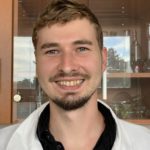Introducing the researchers:
Vojtěch Hamala obtained his MSc at the University of Chemistry and Technology in Prague in 2019. He is a PhD student at the Institute of Chemical Process Fundamentals in Prague under the supervision of Dr Jindřich Karban. His main interests focus on the synthesis of cytotoxic carbohydrate analogues and antitumor carbohydrate-organometallic complexes.
Roman Hrstka obtained his PhD degree in cellular and molecular biology at Masaryk University in Brno. Currently he works as a principal investigator at Masaryk Memorial Cancer Institute. His research is focused on cancer cell signalling and metastasis development. In parallel, he also serves in the Czech national node of the BBMRI-ERIC (European research infrastructure for biobanking).
Petr Voňka graduated in biochemistry and physical chemistry at Palacký University in Olomouc in 2017. He is currently studying for his PhD degree in experimental biology under the supervision of Assoc. prof. Roman Hrstka at Palacký University in Olomouc. His research is focused on the interactions of small molecules (steroids or organometallic compounds) with selected proteins.
Martin Balouch obtained his MSc at the University of Chemistry and Technology in Prague where he continues to study for his PhD degree. He combines pharmaceutical research under prof. Stepanek (UCT Prague) with in silico permeation models under supervision of doc. Karel Berka (UP Olomouc). His research is focused on molecule/biomembrane interactions using both experimental and computational approaches.
Petra Cuřínová obtained her PhD in organic chemistry at the University of Chemistry and Technology in Prague. After the return from the Exeter University (UK) where she dealt with the synthesis and properties of anion-recognizing receptors, she continued her carrier at the Institute of Chemical Process Fundamentals in Prague. She won the O. Wichterle Award for young scientists in 2016. Her main areas of interest comprise preparation, characterisation and application of host-guest systems, chiral recognition and spectroscopic methods.
Jindřich Karban received his PhD in organic chemistry in 1998 under the supervision of Prof Miloslav Černý at Charles University in Prague. After a few years of practise in analytical chemistry and mass spectrometry, he continued his research in carbohydrate chemistry as a senior scientist at the Institute of Chemical Process Fundamentals in Prague. His research interests include the synthesis and properties of fluorinated sugar analogues and antitumor carbohydrate-organometallic conjugates.
Lucie Červenková Šťastná obtained her PhD in organic technology at the University of Chemistry and Technology in Prague where she studied fluorinated cyclopentadienyl complexes. Recently she started working as a researcher at the Institute of Chemical Process Fundamentals in Prague. Her research is focused on structure elucidation by NMR spectroscopy, catalysis and fluorinated sugar analogues.
Martin Kurfiřt obtained his MSc in the field of organic chemistry at the University of Chemistry and Technology in Prague in 2019. He is currently a PhD student at the Institute of Chemical Process Fundamentals in Prague under the supervision of Dr Jindřich Karban. His professional interests comprise the organic synthesis of carbohydrates and study of their interactions with proteins by NMR spectroscopy.
What inspired your research in this area?
Our research in this area was motivated by curiosity. Two separate facts had been known: (1) acylated 2-acetamido-pyranoses become moderately cytotoxic if we selectively deprotect the anomeric hydroxyl group and increase the acyl chain length at the remaining hydroxyls from acetyl to butyryl, (2) fluorination of some monosaccharides renders them cytotoxic. We wished to know what would happen to cytotoxicity if we combine these structural features in one molecule. Therefore, we synthesised fluorinated acylated glucosamine and galactosamine analogues possessing a free anomeric hydroxyl (hemiacetals) and two-to-four carbon acyl chains at the non-anomeric positions, and determined their cytotoxicity.
What do you personally feel is the most interesting/important outcome of your study?
We suggested a hypothesis that the observed cytotoxicity could be the result of the recently discovered nonspecific glycosylation of histidine residues termed S-glyco-modification (J. Am. Chem. Soc. 2020, 142, 9382–9388.) This reaction occurs when acylated amino sugar hemiacetals react with histidine residues by an elimination-addition mechanism in a protein microenvironment rich in lysine. Surprisingly, there was no correlation between the cytotoxicity of our compounds and their ability to react with the thiol group by the suggested mechanism in vitro. This indicates that our compounds probably exert their cytotoxic properties by other, so far unspecified or unknown mechanisms.
What directions are you planning to take with your research in future?
We want to prepare conjugates of some of the most cytotoxic fluorinated hemiacetals with cytotoxic or anti-invasive ruthenium complexes. We expect that conjugation of a ruthenium complex to a cytotoxic sugar may potentiate their antitumor properties. At the moment we work on a suitable synthetic method to link an antitumor ruthenium complex to fluorinated amino sugar hemiacetals.
Read the full article: The effect of deoxyfluorination and O-acylation on the cytotoxicity of N-acetyl-D-gluco- and D-galactosamine hemiacetals
See the other articles showcased in this month’s Editor’s Collection
See every article in the full Editor’s Collection


















